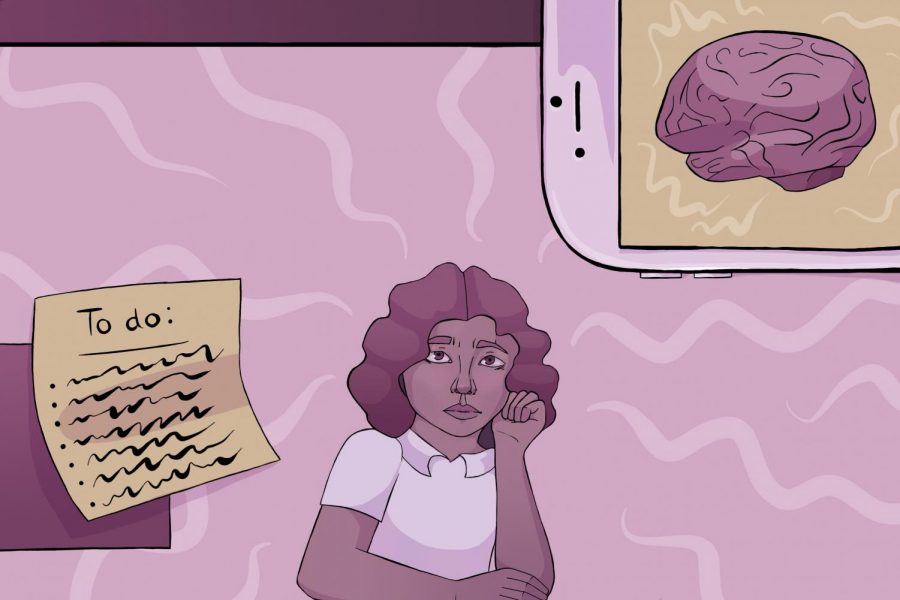In Online School, Mental Health is Hurting: How Do We Move Forward?
There is an unforeseen, quiet emergency infiltrating (virtual) classrooms across the globe. While families struggle to piece together a sense of routine and normalcy seven months into the coronavirus pandemic, teen anxiety, depression, and stress levels continue to skyrocket. The overarching, no-end-in-sight unease of COVID-19 is acutely destabilizing students — even those who thrive academically in a largely self-paced virtual environment.
Spyglass spoke with a wide range of Westridge students, teachers, and student support team members to determine this issue’s presence in our own community and how we can combat it.
The Problem
Some subjects are easier to learn online than others, says new 9th grader Sarah H. While Sarah does like online learning and tries to keep a positive attitude, she still feels the repercussions of “Microsoft Teams fatigue” on a day-to-day basis. “It kind of takes a toll on you because it’s really long and it feels like a long time — especially to be staring at a screen for five and a half hours — and then having to do homework, too.”
Florence J. ‘25 shares a similar sentiment: “It can be draining, sitting in the same room every day. In the past, when I’d move around from class to class, there was some sort of structure. Now, I’m just sitting in the same desk staring at a screen all day.”
When asked what might improve their online learning experience, Florence and Sarah agreed: less screen time. And not just on-camera, synchronous learning, but less screen-centric homework and projects, too, because the mental wear-and-tear of online learning extends beyond school hours.
Faculty members are blown away by students’ adaptability and progress through online learning, but wary of the social repercussions of isolation.
“I’m impressed by how most students have handled it, and it’s not easy,” voiced Human Development teacher Regina Wei. “Let me just say, it’s really, really not easy. But a lot of students — they’ve adjusted. That said, it’s a lot of screen time, and it’s exhausting, and it’s a lot of stress, too, because now students don’t have the option of going up to teachers and asking questions. They have to arrange appointments and it’s all through the screen. And, they don’t have the social time that they normally [do].”
Human Development Coordinator Sarah Simon added, “It’s hard to maintain relationships, to get closer with people you, maybe, became friends with last year, things like that, because we can’t do things the way we normally would.” The rigid formality of virtual socialization, coupled with the overarching “Zoom fatigue” that plagues so many aspects of online life, even makes personal interactions all the more difficult.
For faculty, too, online learning has posed a unique challenge.
“Teachers may be the adults in the room, but we are human and are equally feeling the current stress of this life, too,” said Westridge’s Learning Support Specialist, Tami Millard. “We are taking care of ourselves so we can take care of [our students].”
With the physical boundaries of professional and private life blurred and school-day scheduling limitations — not to mention the added logistical stress and rigid formality of communicating through a screen — teachers are working hard to provide the same individualized support and quality of education usually offered in person. Meeting often with students during lunches, before and after school, and even on weekends, teachers are going well beyond the bounds of the school day to accommodate their students’ needs — a service which, they admit, is a significant undertaking.
“Westridge teachers are truly working harder than they ever have before. They are trying to stay connected to their students and to offer a rich learning environment in less than ideal circumstances. That is its own stressor,” explained Millard.
Many teachers also touched on the social isolation of online learning. During a teacher’s typical school year, noted Sarah Simon, most at-work social interaction takes place casually, in offices or hallways during breaks and between classes. Unlike with students, who are generally more likely to socialize with one another outside of the classroom setting, those conversations are often the only time to forge connections with colleagues. Now, teachers only have access to the individuals they work with directly, which is an especially difficult reality for those who, like Simon, are new to the school.
What the Experts Say
In an email, Tami Millard summed up the physiological repercussions of online learning:
“We have to acknowledge that on a global scale we are collectively experiencing adversity, trauma, and grief and this is ‘not normal.’ A few things are happening in our minds and bodies as a result. Our nervous systems are in overdrive because we can’t seem to find predictability and the sense of safety that comes with that and our brains like predictability and safety. Second, we can’t be connected in a real 3-D way and we are hardwired for connection with others. So, our own sense of self and relationship to each other and the world is off-kilter. Finally, on an evolutionary level, our brains and bodies have not caught up what technology demands of us. All of this leads to students wondering why they are struggling to remain engaged in school.”
Westridge’s latest remote learning survey, released on November 21st, noted the administration’s continued efforts to support mental health, writing, “student well-being is always our top priority, even more so in this challenging period.” The survey outlined plans to reduce screen time by including short, in-class breaks between activities and bolster connection by implementing more class-wide social time in the lower school. It encouraged students and parents to speak with advisors, division directors, and Director of Counseling & Student Support, Dr. Lisa Carruthers, for individual help.
Moving Forward
While the social and academic challenges of online learning look different for every individual, Westridge’s student support team has a host of tips and tricks to combat the stress and unpredictability of life in quarantine:
Take a Walk
Take a break, get some air, get some exercise, and recharge.
Hug Somebody
Scientific research suggests that physical touch helps relieve stress and elevate mood, so de-stress by hugging a parent, a sibling, or a stuffed bear.
Gratitude
Combat the uncertainty of quarantine by remembering what you are grateful for by way of a journal or a mental list.
Check In With Yourself & Acknowledge Feelings
Online learning can be stressful. It is okay to not be okay! Figuring out feelings and acknowledging those feelings is the first step to feeling better.
Do Something Nice for Someone Else
Especially when physical interaction is so limited, helping others in small ways can have huge rewards for everyone involved. Call an old friend, send a handwritten letter to a relative, or pick up groceries for an elderly neighbor.
Simplify
Online learning takes a toll on our brains and bodies. It is okay to take reasonable shortcuts to make life easier on yourself.
Accomplish, Then Celebrate!
Getting stuff done takes work. Keep track of productivity and celebrate every little quarantine accomplishment!

Ilena is passionate about stories— especially histories— good snacks, and bad puns. She has been on Spyglass for a very long time. Ilena is a senior.

Addie is a senior, and has been illustrating for Spyglass Design since 8th grade. In their free time they enjoy sewing, painting, and watching campy horror...

















![Dr. Zanita Kelly, Director of Lower and Middle School, pictured above, and the rest of Westridge Administration were instrumental to providing Westridge faculty and staff the support they needed after the Eaton fire. "[Teachers] are part of the community," said Dr. Kelly. "Just like our families and students."](https://westridgespyglass.org/wp-content/uploads/2025/03/dr.-kellyyy-1-e1748143600809.png)
















































